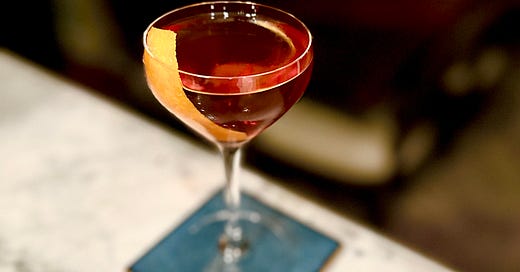For the last two years, this newsletter has kicked off January with low-proof cocktails. This year, we’re going to do the same. But instead of just sampling a handful of drink recipes, I want to dig into what makes low, or at least lower, proof cocktails work.
If you’re the sort of person who follows cocktail trends and innovation, you’ve probably noticed an emphasis on lower-proof cocktails over the last few years. There have been books focused on low-proof drinks, like Natasha David’s excellent Drink Lightly, and low-proof cocktails have popped up on top-tier cocktail menus all over the country, sometimes explicitly labeled as such. The last few times I visited Death & Co. in New York, for example, lower-proof cocktails were explicitly marked. Before it closed last year, The Columbia Room’s final menus listed the alcohol-by-volume of every drink on the menu.
Lower-proof cocktails have appeared on the scene partly as a reaction to the kick-you-in-the-temple stirred-and-boozy drink trends of the craft cocktail movement that grew in the 00s. Even if you’re fairly hearty, you can only drink so many Old Fashioneds in a night. Three-Martini lunches might be a thing of the past, but by dialing back the booze, lower-proof cocktails make three-cocktail evenings easier to enjoy the next morning.
But lower-proof cocktails aren’t merely about transforming what would have been gin-soaked evenings into more alcoholically manageable affairs. They have risen in prominence in part because they allow for the exploration of novel ingredients and unusual flavors, particularly various forms of fortified wine, and sherry in particular.
I suspect that some readers may be skeptical of low-proof cocktails. Don’t be. Half the alcohol doesn’t have to mean half the pleasure. Not only do the best low-proof drinks not sacrifice quality, they can be just as exquisite, just as magical, just as satisfying and surprising and enjoyable, as their higher-proof cousins. Frankly, there are flavor profiles that you simply can’t achieve any other way.
That doesn’t, however, mean that a low-proof cocktail simply replicates the experience of a high-proof drink. Nor does it mean that they can be constructed the same way, although there’s certainly a fair amount of overlap.
So to start 2023, we’ll consider what makes a low-proof cocktail, then take a look at a low-proof classic, the Bamboo, that provides an essential template for the construction of other low-proof stirred drinks. Then we’ll look at a variation or two, and consider how to make your own.
Like, What Even *Is* a Low-Proof Cocktail, Dude?
Before we get to the cocktail recipes, let’s pull back to consider the larger question: What makes a low-proof cocktail a low-proof cocktail?
I think we can start by saying what it’s not: A classic 2:1 Martini or Manhattan is not a low-proof cocktail. Neither is a conventional Old Fashioned.
From there, the question becomes a little bit trickier: Is a Daiquiri a low proof cocktail? Thanks to the inclusion of two non-alcoholic ingredients — lime juice and sugar, which typically make up between 35-50% of the pre-dilution volume — it’s certainly somewhat lower proof than the aforementioned stirred-and-boozy standards. But a Daiquiri also typically has two full ounces of rum. That’s not a low-proof cocktail.
Similarly, a whiskey highball, which contains 3-5 ounces of seltzer, is built around a full pour of a higher proof spirit. Despite the adulteration that comes from topping the drink with soda, I don’t think that counts either.
What about a Negroni? Here the question becomes truly difficult, since a classic equal parts Negroni contains only a single ounce of high-proof spirit, consisting mostly of mid-proof vermouth and Campari. A Negroni made with Cynar, which is lower-ABV than Campari, is lower proof still. The Negroni is what you get if you pray for your cocktail to be low proof — but not too much.
Others have attempted to answer this question in various ways. Several years ago, a pair of Atlanta-based bartenders who wanted to drink less alcohol without reducing the number of drinks they consumed, started a local mini-movement around a style of drink they dubbed the Suppressor. The primary rule for the Suppressor was that no ingredient could contain more than 25 percent alcohol by volume. So no whiskey, no gin, no rum, no Grand Marnier, and no Chartreuse — but Cynar, Aperol, vermouth, and sherry all made the cut.
Another attempt to pin down the form comes from the editors of Punch, in the book Session Cocktails, which posits that a session cocktail can contain no more than ¾ ounce of high-proof spirit. So gin, whiskey, rum, and so on are allowed — but only in modest amounts.
Thus, while all Suppressors are session cocktails, not all session cocktails are Supressors.
For my part, I think such definitional debates are fun but largely academic: What characterizes a low-proof cocktail? How many angels can fit on the head of a pin? What is the correct ratio for a Martini? Some arguments will never be resolved.
But we can make reasonable, good-faith judgments: Drink with a couple ounces of high-proof spirit don’t count in this category. Drinks made entirely with ingredients of 25% ABV or less certainly do. And while difficult-to-pin-down, not-quite-high-proof cocktails like the Negroni might not quite be low proof, they are, at the very least, lower proof, which is what matters.
The Low and Lower Proof Toolkit
As we’ve established, not all low and lower-proof cocktails are Suppressors. But the Suppressor theory of the case was right on a major count: Keeping the proof of a cocktail down means relying on and emphasizing an array of comparatively lower-alcohol ingredients that may be less familiar to some.
So here’s what’s in the lower-proof cocktail toolkit:



